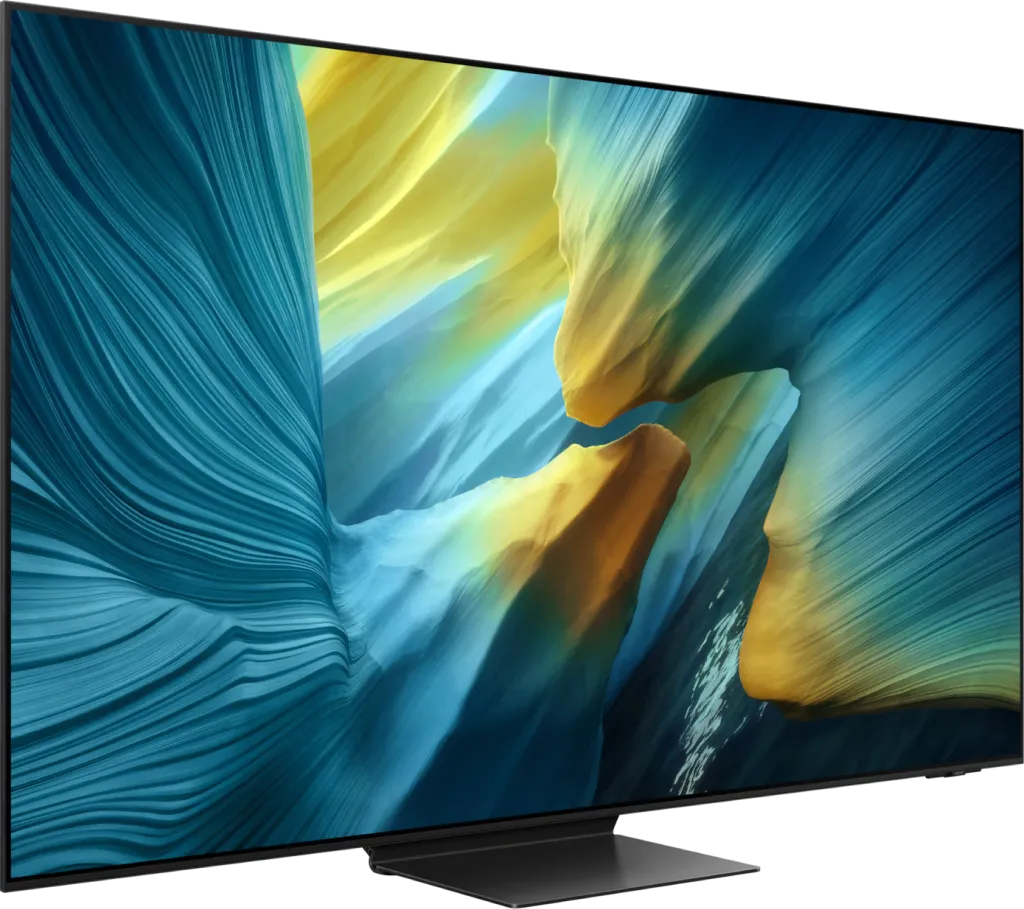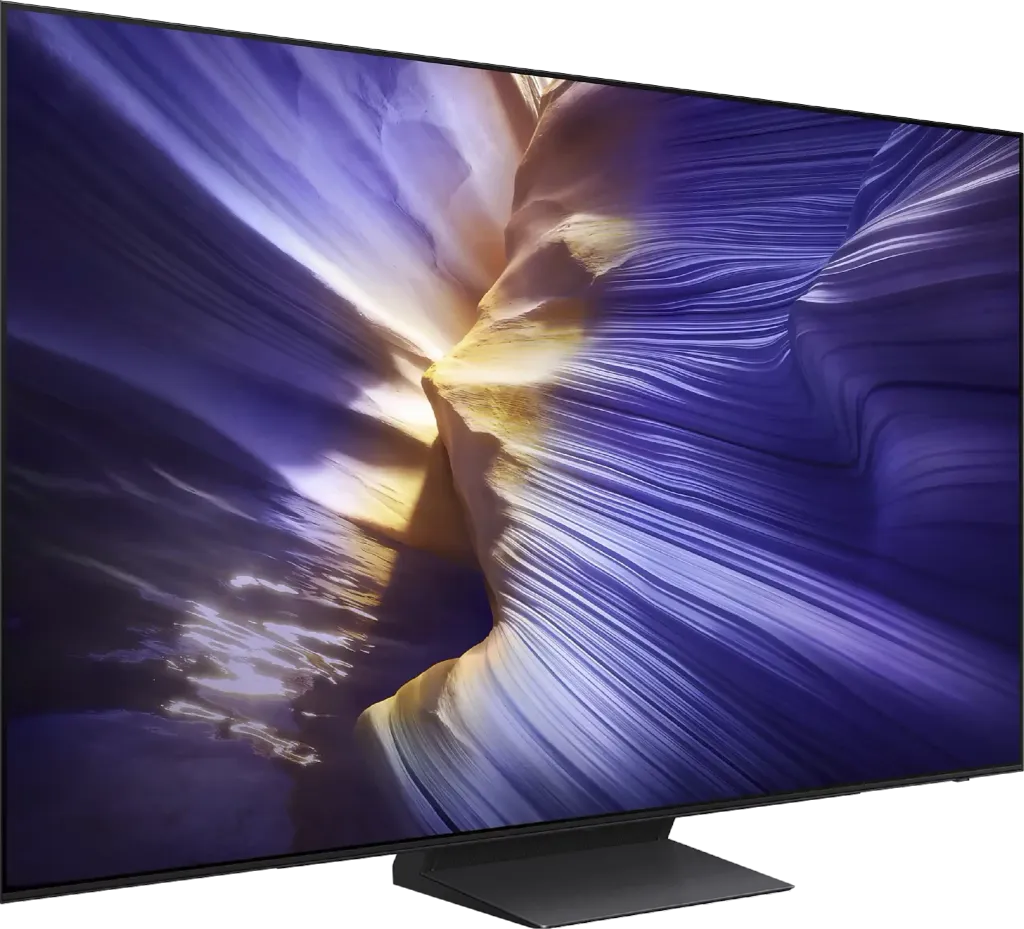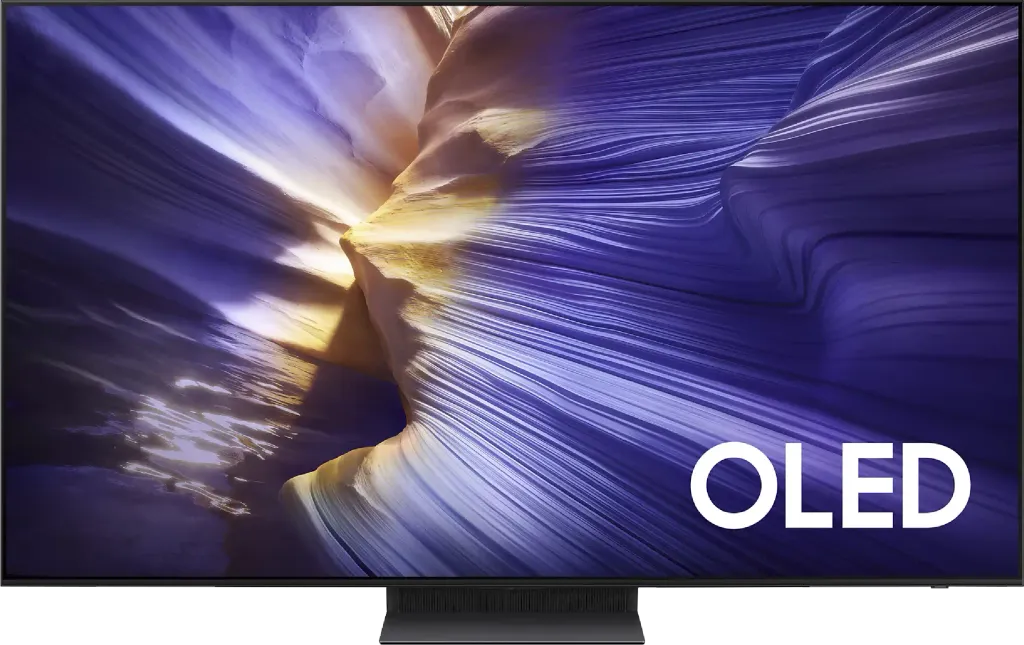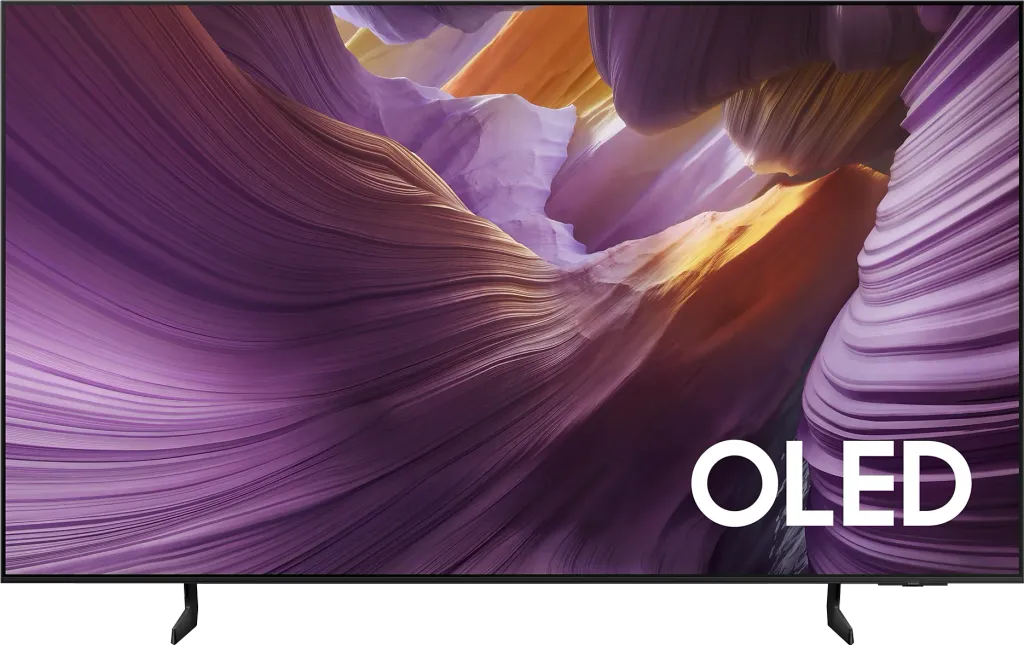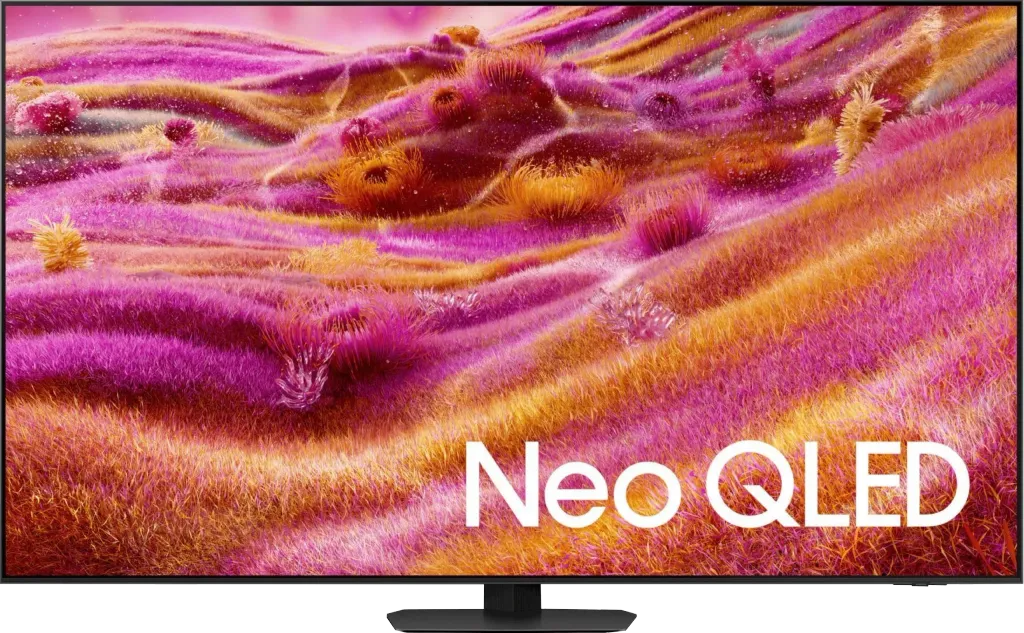TVs SAMSUNG
Samsung has been the largest television manufacturer in the world for years and regularly introduces solutions that others later copy. The lineup includes both simple models for everyday viewing and advanced designs with Mini-LED or QD-OLED technology. Additionally, there is the Tizen system, considered one of the best-developed Smart TVs. Let's take a look at Samsung's offerings, what distinguishes the different series, and what their strengths and weaknesses are.
Samsung Technologies: What is the difference between OLED, Neo QLED, and QLED?
Samsung employs several key display technologies. Here is their direct comparison, from the best to the basic:
Technology | How does it work? | Who is it for? | Key advantages |
OLED (QD-OLED / WOLED) | Samsung uses two types of panels. QD-OLED (proprietary) combines blue OLED pixels with quantum dots. WOLED (purchased) is a panel with white subpixels and a color filter. | For movie lovers and premium gamers. | QD-OLED: The most vibrant colors and high brightness. WOLED: Proven technology, perfect black levels. Both types offer infinite contrast. |
Neo QLED (Mini-LED) | LCD TV with Mini-LED backlighting + Quantum Dot filter. | For bright living rooms, for HDR and gaming enthusiasts. | Extremely high brightness, good black levels (for LCD), minimal burn-in risk. |
QLED | LCD TV + Quantum Dot filter. | For those seeking vibrant colors and good brightness at a reasonable price. | Very good, saturated colors, good brightness at an affordable price. |
Crystal UHD (LED) | Standard 4K LCD TV. | For budget users mainly looking for Smart TV features. | Low price, 4K, great Tizen system. |
Samsung Line-up and Series (2025): What Do the Symbols Mean?
Samsung's hierarchy in 2025 (models with the letter "F") is complicated. Here is a simplified overview of the series:
Series | Panel Type | Positioning (Key Features) | Main Audience |
S95F | OLED (Mixed Panels) | Flagship OLED (4K). Highest brightness in the OLED lineup, top-notch design. Still subject to "panel lottery" (QD-OLED vs WOLED). | Enthusiasts looking for top design and brightness in the OLED class. |
S90F | OLED (Mixed Panels) | Most cost-effective OLED (4K). Great price-to-performance ratio. Also subject to "panel lottery" (QD-OLED vs WOLED). | Demanding gamers and movie buffs (mainstream premium). |
S85F | OLED (Mixed Panels) | Entry into the world of OLED (4K). Lower peak brightness than S90F. Also subject to "panel lottery" (QD-OLED vs WOLED). | Users with a smaller budget looking for OLED quality. |
QN990F | Neo QLED 8K (Mini-LED) | 8K flagship. 8K resolution + wireless One Connect Box. | Design enthusiasts and tech-savvy users who hate cables. |
QN900F | Neo QLED 8K (Mini-LED) | 8K flagship. 8K resolution, but without One Connect Box. Key feature: Matte Screen Coating. | Users in very bright living rooms. |
QN90F / QN92F | Neo QLED 4K (Mini-LED) | Top 4K LCD. Full Array Mini-LED backlighting, high brightness, 144Hz. | Gamers and sports fans in bright living rooms. |
QN85F / QN80F | Neo QLED 4K (Mini-LED) | Mid-range Neo QLED (4K). Full Array Mini-LED backlighting, but fewer zones and lower brightness than QN90. 144Hz. | Users looking for a TV better than QLED, for gaming and sports. |
QN70F | Neo QLED (Edge Mini-LED) | NOTE: 4K model with Edge Mini-LED backlighting, not zoned. Picture quality (contrast, black level) is significantly worse than in QN80F+. | For those looking for the cheapest Samsung 120Hz / 144Hz. |
Q8F / Q7F / Q6F | QLED (LED) | Basic QLED series (4K). Differ in brightness. | Users looking for vibrant colors and a good Tizen system. |
U8000F / U7000F | Crystal UHD (LED) | Basic series (4K). Regular 4K LCD TV with Smart TV. | Less demanding users. |
Strengths and Weaknesses of Samsung TVs
Strengths (+) | Weaknesses (-) |
Wide range of very good TVs. Both OLED and LCD screens. | No support for Dolby Vision HDR format (Samsung promotes its own HDR10+) |
Innovative QD-OLED technology (brighter colors and higher brightness) | "Panel lottery" across the entire lineup, making informed purchasing difficult. |
Fast and extensive Tizen system (Smart Hub, Ambient mode, integration with the ecosystem) | Narrow viewing angles (in most VA panel LCD models). |
Great choice for gamers (Game Mode, 4xHDMI 2.1, 144Hz+, FreeSync) | No support for DTS audio format (a problem only for users of physical home theaters). |
Game Motion Plus. Proprietary motion smoothing working in games! | |
Very good matte anti-reflective coatings (especially in higher series). | |
Pioneer in the "Lifestyle" category (models like The Frame, The Serif, The Sero, which have become design icons in the TV world). | |
Design (slim bezels, One Connect box, Ambient Mode). | |
7 years of update support. |
Samsung vs LG: Which TV brand to choose?
In short: in the LCD (Neo QLED vs QNED) category, Samsung usually wins in terms of picture quality, offering better contrast and deeper blacks (thanks to VA panels) and superior dimming algorithms (especially in the QN80F+ series). In the OLED category, the competition is complicated: Samsung (QD-OLED or WOLED) vs LG (WOLED). In practice, when buying a Samsung (e.g., S90F) and an LG (e.g., C5), you could end up with... the same panel. Both brands also do not support competing formats (Samsung lacks Dolby Vision, LG lacks HDR10+).
Comparison Category | Samsung TVs | LG TVs |
Main LED Technology | QLED / Neo QLED (usually VA panels) | QNED / NanoCell (usually IPS panels) |
Key Advantage in LED | Much better contrast and deeper blacks | Better viewing angles |
Main Premium Technology | QD-OLED and WOLED (mixed panel strategy) | WOLED (one, consistent panel type) |
Key HDR Format | HDR10+ | Dolby Vision |
Smart TV System | Tizen (fast, good integration with devices) | webOS (with Magic Remote) |
Samsung vs Sony
This is a showdown of giants who... often use the same panels. In the premium class, Sony buys QD-OLED panels from Samsung and WOLED from LG. The difference lies in the philosophy. Samsung focuses on brightness and smart/gaming features (Tizen, Game Bar). Sony positions itself as a brand for purists, offering the most natural and reference-grade image processing (XR processor) and the best built-in sound on the market. Sony also uses the Google TV system.
Comparison Category | Samsung TVs | Sony TVs |
OLED Panel | Manufacturer (QD-OLED), but also purchases WOLED | Purchases QD-OLED panels (from Samsung) and WOLED (from LG) |
Picture Processor | NQ AI Processor | Cognitive Processor XR |
Sound | Good (supports Q-Symphony) | Usually the best on the market (e.g., Acoustic Surface). |
Smart TV System | Tizen (fast, but with ads) | Google TV (huge app library) |
For Gamers | Leader in gaming features (Game Bar, 144Hz, Game Motion Plus) | Very good, but often "a step behind" Samsung. |
Price / Value | Very competitive in its class. | Usually significantly more expensive in the same class. |
Frequently Asked Questions about Samsung TVs (FAQ). TOP 10 Questions.
1. Is the lack of Dolby Vision in Samsung TVs a big problem?
Not anymore. By 2025, this argument practically lost its significance. Historically, Samsung's biggest flaw was the lack of support for Dolby Vision (DV), favored by Netflix and Disney+. However, in 2025, the situation changed dramatically:
Netflix and Disney+ now support HDR10+: Both key streaming platforms have introduced full support for the HDR10+ format, which Samsung uses.
Wide availability: Samsung supports the competitive, free format HDR10+ practically in every series of its TVs.
No noticeable difference: Both formats (Dolby Vision and HDR10+) use dynamic metadata (adjusting the picture scene by scene). For the average viewer, the differences between them are practically unnoticeable.
In short: the "format war" at the consumer level has ended. By choosing Samsung, you no longer lose access to the best version of HDR on key VOD platforms.
2. I've heard that OLED TVs suffer from burn-in. Is that still a problem?
In practice – the risk is minimal. It is more of a myth from the early days of OLED technology. Modern Samsung OLED TVs (both QD-OLED and WOLED) feature advanced security systems to prevent this. These include automatic "cleaning" of the panel when turned off, "pixel shifting," which is invisible to the eye, and detection and dimming of static logos (e.g., news ticker). If you use your TV in a standard, varied way (watching movies, series, gaming, switching channels), and do not leave the same static image on for 24 hours a day for many months, the probability of burn-in is practically zero.
3. What is better: Samsung Neo QLED or Samsung OLED?
Samsung OLED offers better picture quality (ideal black, contrast, panel response time). However, Neo QLED (in higher series) can achieve significantly higher peak brightness, making it a better choice for a very sunny living room. For movies and games in normal or dark conditions – OLED wins.
4. Is every Samsung OLED TV a QD-OLED?
ABSOLUTELY NOT. Samsung uses a "panel lottery" across its entire OLED line. This means that when buying an even flagship model, you may receive a QD-OLED (proprietary) panel or WOLED (from LG Display), depending on the diagonal, production date, or market. There is no guarantee of the panel.
5. Is Samsung a good choice for PlayStation 5 and Xbox Series X?
Absolutely yes. Samsung, like LG, is a leader in the gaming segment. OLED and Neo QLED 4K models offer everything: full HDMI 2.1, 4K at 120Hz (and even +144Hz), VRR and FreeSync support, and an extensive "Game Panel" (Game Bar).
6. What distinguishes the S90 series from the flagship S95?
Mainly design, peak brightness, and potentially accessories (like the One Connect Box). BUT both series fall victim to the "panel lottery." The difference comes down to higher brightness and better design in the S95F, regardless of the type of panel you get.
7. Is it worth buying an 8K Samsung TV?
Only if budget is not an issue and you want the largest available screen or if you value a matte finish that handles reflections well in bright daylight. There is virtually no native 8K content. The strength of these TVs lies in the AI processor that scales 4K content to 8K very effectively. However, it is important to remember that they often fall short in quality compared to OLED TVs.
8. How to decipher the name of a Samsung TV? (e.g., 65S90F or 75QN92F)
Example 1: 65S90F (OLED Model)
65 = Screen diagonal in inches.
S = Type of TV. "S" denotes the OLED series.
90 = TV series.
F = Model year. "F" means year 2025 (C=2023, D=2024).
Example 2: 75QN92F (Neo QLED Model)
75 = Screen diagonal in inches.
Q = Type of TV. "Q" denotes the QLED series.
N = Backlight technology. "N" signifies Neo QLED (i.e., Mini-LED).
92 = TV series.
F = Model year. "F" means year 2025. (C=2023, D=2024).
9. How does Q-Symphony technology work?
It is a feature that allows the speakers in the TV and Samsung soundbar to play simultaneously. The TV speakers are not muted but work in "harmony" with the soundbar (compatible with Q-Symphony).
10. Is it worth buying a Samsung TV?
YES, especially if you are targeting OLED and Neo QLED series. Samsung is currently the leader in TV sales for a reason. It is a brand that makes very solid products in practically every category, and at an affordable price. BUT... The only downside worth mentioning is the widely used "panel lottery" by Samsung (mainly in the OLED series). However, it should be noted that often, even if we receive a different panel (e.g., WOLED instead of QD-OLED), it does not deviate significantly in quality from the other panel. You still get a premium product, albeit with slightly different characteristics.
Verdict:
The Samsung S95F is an excellent continuation and an improvement over last year's S95D model. Thanks to the QD-OLED panel, we get an image that delights from the first minutes of the viewing experience. The blacks are deep and natural, without signs of backlighting, and the brightness of the next-generation panel reaches levels that just recently seemed out of reach for OLEDs. These values are so ...
Rating
8.7/10

Movies and series in UHD quality
9.3
Classic TV, YouTube
9.3
Sports broadcasts (TV and apps)
8.9
Gaming on console
9.9
TV as a computer monitor
8.8
Watching in bright light
7.1
Utility functions
7.9
Apps
8.7
Sound quality
8.0
Buy this TV:
Verdict:
In the case of the 83-inch version, Samsung took a different path than with the smaller diagonals and opted for the Tandem WOLED panel produced by LG Display. This move initially raised questions, but in practice, it turned out to be a bullseye. We have here an exceptionally successful mix: absolutely reference black, excellent brightness allowing for enjoyment of HDR content even during the day, ...
Rating
8.7/10

Movies and series in UHD quality
9.0
Classic TV, YouTube
9.0
Sports broadcasts (TV and apps)
8.6
Gaming on console
9.8
TV as a computer monitor
8.8
Watching in bright light
7.7
Utility functions
7.9
Apps
8.7
Sound quality
8.0
Verdict:
The Samsung S95D stands out as a top choice in Samsung’s 2024 lineup, featuring an innovative matte display that minimises reflections and performs impressively in both low-light and daylight conditions. This model is among the brightest in the OLED segment, offering exceptional visibility in any room. With excellent motion fluidity, it handles fast-paced content like sports or gaming with precisi...
Rating
8.5/10
Movies and series in UHD quality
8.9
Classic TV, YouTube
9.2
Sports broadcasts (TV and apps)
8.9
Gaming on console
9.8
TV as a computer monitor
8.6
Watching in bright light
6.2
Utility functions
7.9
Apps
8.7
Sound quality
7.9
Buy this TV:
Verdict:
The 65-inch Samsung S90F is a television that demonstrates how significant a quality leap can come from the use of QD-OLED technology in a mid-range model. Among other variants, the S90F stands out as the best – it offers not only perfect black and infinite contrast like other models with WOLED panels but also noticeably higher brightness and a wider color gamut. This translates into more impressi...
Rating
8.4/10

Movies and series in UHD quality
9.0
Classic TV, YouTube
9.3
Sports broadcasts (TV and apps)
8.9
Gaming on console
9.8
TV as a computer monitor
8.6
Watching in bright light
5.7
Utility functions
7.7
Apps
8.7
Sound quality
7.4
Buy this TV:
Verdict:
The Samsung S90D TV is a model full of pleasant surprises, offering excellent picture quality and modern technologies. It is worth noting that depending on the size, the TV may differ in the type of OLED panel used. The tested model, equipped with a QD-OLED panel, delivers flawless black levels and intense, vivid colours. Thanks to its exceptional brightness, HDR effects make a huge impression, an...
Rating
8.2/10
Movies and series in UHD quality
8.5
Classic TV, YouTube
9.2
Sports broadcasts (TV and apps)
8.9
Gaming on console
9.6
TV as a computer monitor
8.6
Watching in bright light
5.3
Utility functions
7.4
Apps
8.7
Sound quality
7.4
Buy this TV:
Verdict:
The Samsung S90F is an excellent representative of the premium mid-range in the world of OLED televisions. Here we have an organic matrix that guarantees perfect contrast – and no matter how hard LCD manufacturers try with local dimming in Mini LEDs, this black simply cannot be replicated. The S90F displays its class here without any compromises. Compared to last year's model, we get a slightly br...
Rating
8.2/10

Movies and series in UHD quality
8.3
Classic TV, YouTube
8.7
Sports broadcasts (TV and apps)
8.5
Gaming on console
9.6
TV as a computer monitor
8.6
Watching in bright light
6.1
Utility functions
7.7
Apps
8.7
Sound quality
7.4
Buy this TV:
Verdict:
The Samsung S90D (or S94D) TV is a model that surprises in many ways, offering exceptional performance across various aspects. One key feature to note is that depending on the size of the television, it may differ in the OLED panel variants used. Regardless of the specific panel technology, the S90D guarantees perfect blacks, and its HDR light effects, aided by high brightness, truly impress, crea...
Rating
8.1/10
Movies and series in UHD quality
8.2
Classic TV, YouTube
8.7
Sports broadcasts (TV and apps)
8.5
Gaming on console
9.5
TV as a computer monitor
8.6
Watching in bright light
6.0
Utility functions
7.4
Apps
8.7
Sound quality
7.4
Buy this TV:
Verdict:
Samsung S85F with a QD-OLED panel can be surprising – and surprisingly positively so. Before the tests, we didn't think that in the case of televisions, which are often referred to in the context of "panel lottery," one could come across something beneficial for users. Yet, in this case, especially in the 55-inch version, it fully succeeded. The QD-OLED panel, as is fitting for organic technology,...
Rating
8.0/10

Movies and series in UHD quality
8.4
Classic TV, YouTube
9.2
Sports broadcasts (TV and apps)
8.9
Gaming on console
9.3
TV as a computer monitor
7.6
Watching in bright light
5.1
Utility functions
7.3
Apps
8.7
Sound quality
7.2
Buy this TV:
Verdict:
The Samsung S90D TV in its smallest variant is a model that excels in many respects. It performs impressively in displaying details in dark scenes, enhancing the experience of watching demanding productions. However, the 48-inch variant has slightly lower brightness compared to larger models, and the screen features a satin finish rather than a glossy one, which can affect daytime viewing. Regardl...
Rating
7.9/10
Movies and series in UHD quality
8.0
Classic TV, YouTube
8.6
Sports broadcasts (TV and apps)
8.4
Gaming on console
9.4
TV as a computer monitor
8.6
Watching in bright light
5.4
Utility functions
7.4
Apps
8.7
Sound quality
6.8
Buy this TV:
Available screen sizes: 43”, 50”, 55”, 65”, 75”, 85”
Technology: LCD VA, Mini-LED QLED
Brand: SAMSUNG
Verdict:
The Samsung QN90F is a television that, in many ways, demonstrates how mature the development of miniLED technology can be. It offers excellent contrast and blacks, very high HDR brightness that works well in both movies and games, and a matte screen that makes a huge difference in everyday use. This is what makes the QN90F one of the best televisions for watching in sunny living rooms – reflectio...
Rating
7.8/10

Movies and series in UHD quality
7.8
Classic TV, YouTube
7.6
Sports broadcasts (TV and apps)
7.2
Gaming on console
8.8
TV as a computer monitor
8.8
Watching in bright light
7.2
Utility functions
7.7
Apps
8.7
Sound quality
7.8
Buy this TV:
See articles related to
Shopping Reviews
The best Samsung TVs 2024 / 2025! Which Samsung TV to choose... 4/30/2025
1/15/2025
Our YouTube channel
Smart calibration of Samsung TV in SmartThing? 6/23/2025
2/15/2025
2/4/2025


